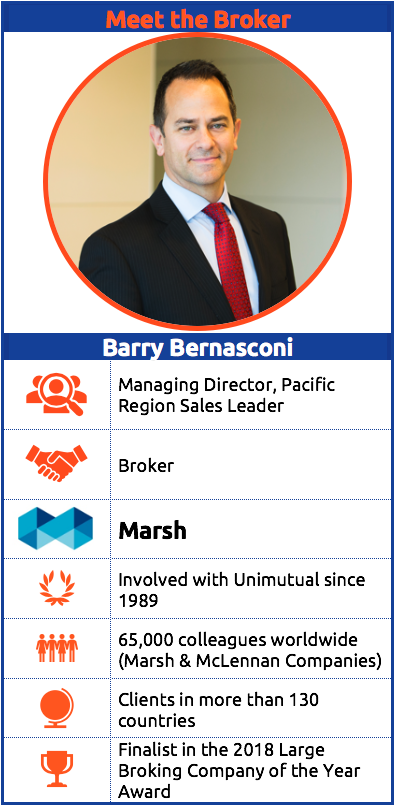
Strategic Risks & Opportunities for 21st Century Risk Registers
May 14, 2019
Drone Risks and Your Unimutual Cover
May 21, 2019In these Spotlight discussions, we feature the individuals that make up our ecosystem – what they each bring to our community, and what they gain from it.
 I’m Barry Bernasconi, I work for Marsh here in Australia, the Insurance Broker. I’ve been with them for almost 20 years now. I’m a Managing Director in Australia, on our Executive [Committee], and for the last 10 years I’ve been heading up our educational practice in Australia.
I’m Barry Bernasconi, I work for Marsh here in Australia, the Insurance Broker. I’ve been with them for almost 20 years now. I’m a Managing Director in Australia, on our Executive [Committee], and for the last 10 years I’ve been heading up our educational practice in Australia.
Tell us about Marsh’s relationship history with Unimutual
It goes back a long way, well before my time, so even back to the inception of Unimutual back in, I think it was 1989. Marsh were involved way back then, and UTAS, which is still our client now, they’re a founding Member of Unimutual. So the engagement’s been going for a very long time, much longer than I’ve been around. But it’s an excellent relationship.
What do Unimutual services mean to Marsh and to Marsh’s clients?
Key thing for us is, we put a lot of focus on industry expertise, so when you look at what Unimutual stands for, and it’s owned by the Members for the Members in that space. You’re not dealing with generalists, everything we’re talking about is focused on the higher education sector. I think that’s massively important for the clients that are in Unimutual.
What sets the higher education sector apart in terms of its risk needs?
It’s massively complicated. You look at a university, you’ve got global international risks, you’re a mini conglomerate. You’ve got faculties that are producing stuff, you’ve got medical divisions, you’ve got engineering divisions, people flying drones. That’s the fascination for me is the complexity of stuff that’s in those. Every day, every two universities are not the same, every day isn’t the same and even just trying to get the business description right for an insurer to say, now what do they do? We tend to rely on that, and you kind of want to say, well they do everything.
You see some of the weird and wonderful things come out, you know, from performing arts and what they try and do with people and hanging them from sculptures to people digging two-kilometre-deep holes in the middle of the university, so just being part of that forefront of technological advancement brings new risk.
What are the upcoming trends that you see in the Australian market and how will these impact your customers?
Well the big thing at the moment is the discussion around a transitioning or a hardening market, and yes premiums are getting more expensive, the cost of risk transfer is getting more expensive. But that’s been coming for a couple of years now, we’ve known about that, and you know it’s, we’ve talked about the insurance markets recovering back to the prices that were there a few years ago, so whilst that’s happening, I wouldn’t say it’s necessarily unexpected. When you have a look at the losses though, that’s where stuff is changing. There’s two big components there: one is climate change, so there are all these big weather events happening more and more often, you know. Look at the hurricane season last year with three major hurricanes in pretty close succession as well. So climate events happen more often, so I think it’s redefining what the probability of those events is, is going to be critical.
And the other big thing is, still if we keep talking about cyber, but just the internet of things, the connectiveness of everything, and think about where we are going to be in five to ten years’ time and how everything we do is going to depend on technology and connectivity, that’s going to be a huge risk for us and I don’t think we yet fully understand and embrace what that’s going to mean.
Why is cyber such a prevalent concern?
A lot of what we do is predicated on past and history, and insurance industry is great at looking back and saying this is what actually happened, this is what went wrong, so therefore, this is how we’ll plan the future. In the cyber and AI sphere, it’s all new there is no history, so you’re sort of trying to keep up as you go along. That’s going to be the challenge, that I see there.
How do you estimate for such a new risk?
You get a lot of really smart people, which universities have and you run a lot of models, so that quantitative modelling aspect, big data is key to all of this. There’s fantastic opportunity, but the risk piece, is the piece we don’t really know until we get there and someone goes, wow, how did that manifest and what do we do with it now? So that’s going to be the exciting piece, huge opportunity but we don’t know what the risk is yet, so you just got to keep pace all the time. We’ve seen that in the development of cyber policies, you know from where they started three, four, five years ago, to what they are now, chalk and cheese.
What importance does broking have for risk protection?
The brokering community, our role is to advocate for the client and to advise the client, so universities are no different. So we always start with a discussion based on risk, it’s maybe a popular misconception that brokers are all about insurance. Insurance is the ultimate thing we get to for risk transfer, but the conversation always starts with risk and advice. That’s what our clients rely on us for, that’s why we’re there in partnership, with Unimutual as well, so the clients get advice from Unimutual, which is where the risk transfer actually sits, but they rely on us as well, and I think there is always an obligation on us as well to be, to challenge clients in their thinking, about what they’re trying to do and how they’re trying to do it. But then also our job is to challenge Unimutual, and definitely Unimutual partner well with us as a broker, because where we’re trying to change and improve wording, you know a lot of that comes from us, where we’re trying to advocate for our clients and that feeds into Unimutual, for the benefit of all the universities. It is a really good tripartite relationship. But the advisory component is really important. It’s not Marsh – to the client – to the university: it truly is the three together and that’s the only way it can truly succeed, you have to be in a true tripartite relationship.
How do you provide cover for intangible assets like reputation or research?
Intangible assets is a huge area that hasn’t properly been covered by the insurance world and risk management, so it sits by the side because it’s not visible, it’s not there, you can’t touch it ,and feel it, and move it. Reputation is a massive issue for any of the universities. We talked about that in the sessions yesterday, you see parents overseas who are Googling a university and saying shall I send my child here? Depending on what they see, will define whether they say, actually Australia is a good place to send them or a particular university is a good place, or actually I’m going to send my kids to Canada because I don’t like what I see. So there is all of that management of the intangible that comes in there. That directly feeds into, obviously, universities income. We all know about the challenges of funding in universities, so these are critical things that are completely intangible, that we have to get right.
How important is the relationship between brokers and risk protection providers?
We always use the analogy, you know, you don’t want to be sort of arm’s length and then the first time you interact with the risk protection provider and insurer is when there’s $20m loss on the table. And it always comes down, when the claim eventually happens as it does, that’s when you get to see the value of that relationship, and the claims that run smoothly, where there is good engagement, losses clearly defined quickly, is because of that relationship, where you don’t have that, that’s when you get into some stickiness along the way.
“The unique value proposition of the mutual is it’s discretionary…the Members who are on the claims panel, looking at these losses and [asking] could it happen to me? It’s not in the wording but is it something we should be looking at?…So, owned by the Members for the Members has particular value.”
Does Unimutual’s claims handing process set them apart from other providers?
I think so, I think the unique value proposition of the mutual is it’s a discretionary mutual. Some people look at that word discretionary and take it as a negative, definitely through my engagement with Unimutual, I see it as a positive. It’s the Members who are in there, on the claims panel, and looking at these losses and they’ve always got in their head “could it happen to me? It’s not in the wording, but is it something we should be looking at?” So I think discretionary is a really valuable piece in there and that feeds directly into the claims. So, to be able to get a settlement expedited, where maybe in the commercial insurance market you wouldn’t be able to do that, so there is a huge amount of value in that alone. So, owned by the Members for the Members has a particular value proposition.
How do you help balance the conversation around price vs value with your customers?
The key thing I always try and talk to all our clients about is, you can’t just price for today. When you look at anything to do with risk and where you’re spending your money, you have to take a long term, economic view of the impact of those decisions you are making today. The industry is very good at looking in the rear-view mirror, but all the risk that we face is in the future. So we need to become better at actually looking at the long term, and the volatility of risk that’s coming.
So pricing exercise is always the last thing that we should be doing and it is important, it’s challenging in a market, in an industry, where funding is becoming harder and harder and harder. It was clear yesterday the number one thing that the audience voted for, in terms of top risk was funding, so when you’re in this market and you go back to university and you might say this could be a 10% increase in premiums, or we would like to deliver this service and it’s going to cost you X, that gets weighed against a whole bunch of other cost considerations. But the uniqueness of what we are doing in this space, in the risk space, in the insurance landscape, is the decisions we make today will impact us well into the future. So if you look at a liability policy the claims aren’t there for the last year or this year, the claims could be there for stuff that’s going to happen in seven, or manifest itself in seven years’ time, eight years’ time.
What opportunities are on the horizon for Australian higher education and research?
You look at the collective knowledge that sits in those universities and the problems that we can solve, when even trying to relate that back to uninsurable risk, the use of big data and the collaboration that goes on, I’m sure we could solve a whole bunch of things. From a risk perspective, you look at the embracing artificial intelligence, embracing big data and how that can remove risk from society, that goes beyond just protecting the universities themselves. It’s about broader society, the research that’s currently going on into helping to make countries fitter just through urban design, those are really cool things and that’s risk for everyone, so we need to keep the funding, we need to keep the research going on that stuff, but try and take the research and try and apply it to risk in general, so that it’s firmly linked into that risk space. It’s good to see.
We previously spoke to Chairman Martin Griffith – read his responses here.



